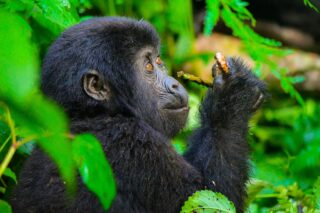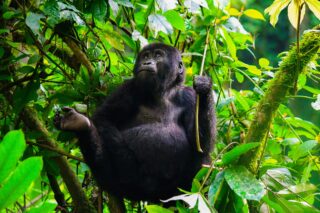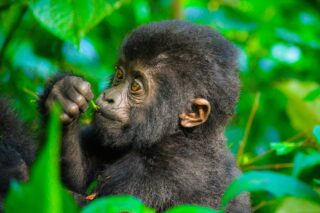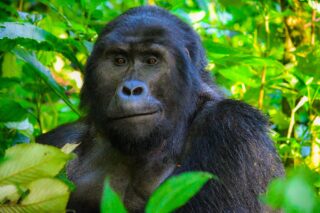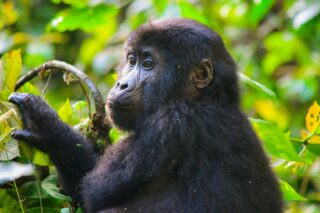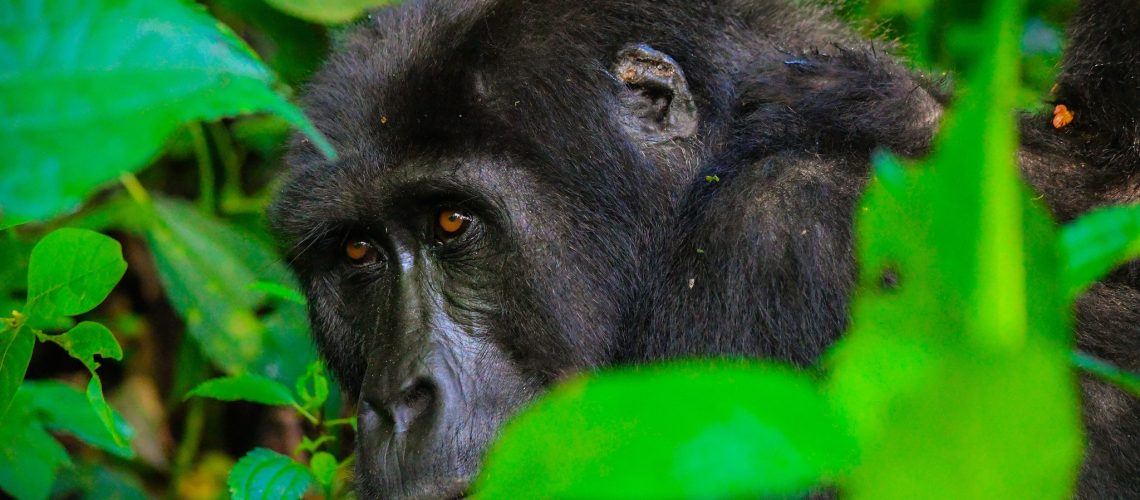The Pearl of Africa is a perfect name for Uganda, a biologically rich and diverse jewel of a country with subtropical jungles, cloud-shrouded forests, savannas filled with wildlife, snow-capped volcanic peaks, and many lakes and rivers, including the famous Nile River.
Kibale National Park in Uganda is known as the “Primate Capital of the World” because it has the largest population and variety of primates in Africa. The 191,700-acre protected reserve in Kabarole district, Western Uganda is home to 13 different primate species, including: chimpanzees, black and white colobus monkeys, red colobus monkeys and olive baboons.
There are four subpopulations of the chimpanzee — the western chimp, the Nigeria-Cameroon chimp, the central chimp, and the eastern chimp. This great ape is one of our closest relatives, sharing about 98 percent of their genes with us. They have thickset bodies with short legs, opposable thumbs, no tails, and long arms that are 1.5 times their height that extends beyond their knees. Much of their body is covered with long black hair, but the face, ears, fingers, and toes are bare.
Females in estrus have a prominent swelling of the pink perineal skin that lasts two to three weeks and occurs every four to six weeks.
Chimpanzees are endangered due to habitat loss and hunting. Scientists estimate there are between 170,000 and 300,000 chimpanzees currently living in the wild.

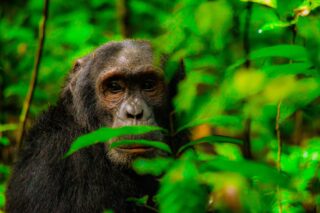
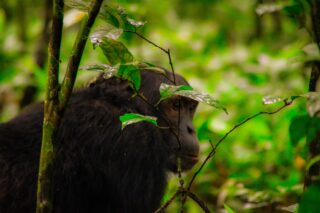
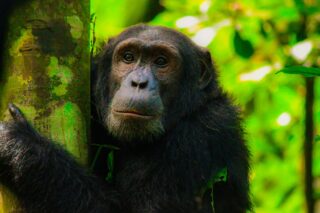
Kibale National Park commonly known as “the home of chimps and primate capital of the world”, lies in Western Uganda. The park stretches through Kabarole, Kamwenge, Kyenjojo and Kasese districts. It’s just 26 miles Southeast of Fort Portal city, among gently undulating lush green hills of cultivation.
The black-crested mangabey, also known as the white-cheeked mangabey, and grey-cheeked mangabeys are some of the 13 primates that you may not miss to see while at Kibale Forest National Park.
Chimpanzee trekking is mainly done in the Kibale Forest National Park and other destinations where you can go for the chimpanzee trek include the Budongo forest which is found in the Murchison Falls National park, Kyambura gorge in the Queen Elizabeth National Park, Semuliki wildlife reserve, and Kalinzu forest found in Busenyi.
Chimpanzee trekking starts very early in the morning and every trek begins with the tour guides giving tourists the guidelines and rules that need to be followed. While trekking, you will be able to see other primates and wildlife like the red-tailed monkeys, black and white colobus monkeys, a variety of bird species among others.
Just like the trekking permit for gorillas, limited permits are printed per day and these are only valid for the date that they have been printed. The reason as to why few permits are printed is to try as much as possible to reduce the interaction between the chimpanzees and humans to conserve them. The chimps are prone to diseases and that is why interaction is limited.
Chimpanzee trekking starts very early in the morning and every trek begins with the tour guides giving tourists the guidelines and rules that need to be followed. While trekking, you will be able to see other primates and wildlife like the red-tailed monkeys, black and white colobus monkeys, a variety of bird species among others.
Just like the trekking permit for gorillas, limited permits are printed per day and these are only valid for the date that they have been printed. The reason as to why few permits are printed is to try as much as possible to reduce the interaction between the chimpanzees and humans to conserve them. The chimps are prone to diseases and that is why interaction is limited.
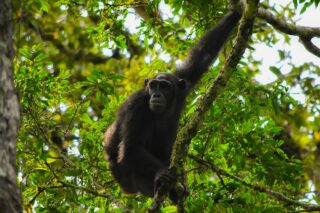

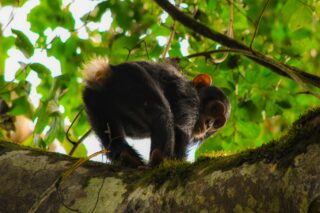
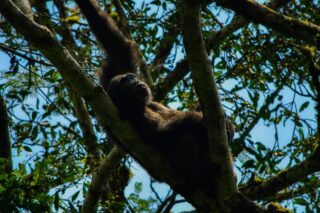
Found across 25 countries throughout equatorial Africa, the olive baboon (Papio anubis)—also referred to as the savanna monkey or Anubis baboon—has the most expansive range of any baboon species.
Whether they are perched atop a steep, jagged slope overlooking sunlit grassy plains, or scurrying on all fours across semi-desert landscapes, olive baboons have established a formidable presence throughout the sub-Saharan region of the continent. These hardy and adaptive primates inhabit savannas, tropical evergreen forests, semi-deserts, steppes, montane forests, semi-arid woodlands, and even areas near human settlements.
From the Ethiopian riverbeds of the Bole Valley to the open woodlands of Uganda, so long as there is a water source nearby, olive baboons are able to call it home.
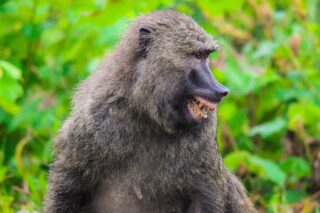
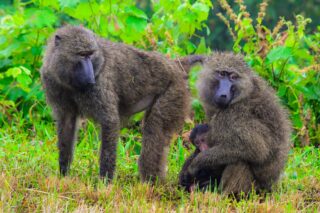
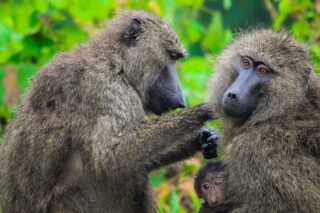
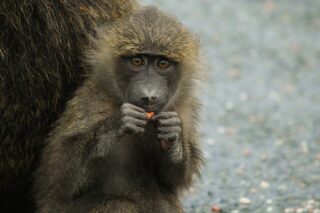
Africa is home to red colobus monkeys that are remarkably diverse. They differ in behavior, vocalizations, facial expressions, and even coat colors and patterns.
Instead of thumbs, they have a small remnant bump. They can ferment leaves in their guts and digest plant matter, and are the primary prey for chimpanzees.
These monkeys rarely descend to the ground. They use branches as trampolines, jumping up and down on them to get liftoff for leaps of up to 15 meters (50 feet). They leap up and then drop downward, falling with outstretched arms and legs to grab the next branch. Their mantle hair and tails are believed to act as a parachute during these long leaps. They are a highly arboreal species; however, when the trees are not as dense, they will descend to the ground to hunt and feed.
Bigodi Wetlands Sanctuary is a community development effort at the edges of Kibale National Park to help protect the former Magombe Swamp.
The Bigodi Wetland Sanctuary is an fascinating area, located in Magombe swamp. This area is recognized for a extensive array of biodiversity among which are several primates species like the red colobus monkey, baboon, black & white colobus monkey, blue monkey grey cheeked, mangabey, vervet monkey, red tailed monkey and the L’Hoest monkey. Additional mammals such as chimpanzees, Sitatunga, mongooses, bush pigs, otters plus bush bucks, also visit this swamp coming from the adjacent Kibale National Park.
Black-and-white colobuses are Old World monkeys of the genus Colobus, native to Africa.
The name “colobus” is derived from the Greek word for “mutilated,” because unlike other monkeys, colobus monkeys do not have thumbs. Their beautiful black fur strongly contrasts with the long white mantle, whiskers, bushy tail, and beard around the face. The Eastern black-and-white is distinguishable by a U-shaped cape of white hair running from the shoulders to lower back, whereas the Angolan black-and-white has white hairs flaring out only at the shoulders.
The habitat of a colobus includes primary and secondary forest, riverine forest, and wooded grasslands in equatorial Africa.
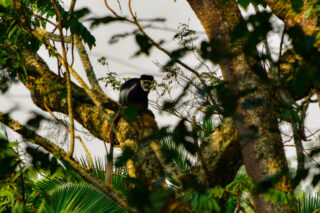
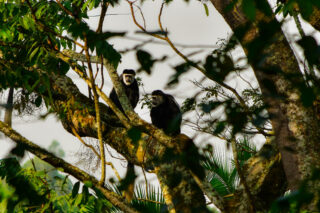
Kibale national park truly beats all other African countries when it comes to primate population and species; it harbors over 1500 chimpanzees. This is the reason as to why it is called the primate capital of the world.
Primate species in the Primates Capital of the World (Uganda) include the latest discovered Dwarf Galago, mountain gorillas in Bwindi Impenetrable National Park and Mgahinga Gorilla National Park, chimpanzees in Kibale Forest, Kyambura Gorge, Budongo Forest, and Kalinzu Forest. Other primates include the black-and-white-colobus monkey, red-tailed monkey, grey-cheeked mangabey, I’Hoest’s monkey, blue monkey, and olive baboons. The bushbaby and potto are some of the nocturnal primates that can be seen on a night game drive during wildlife safaris in Uganda. The golden monkeys are endemic to the Virunga Mountains and Uganda is lucky to have these species only in Mgahinga National Park.
Bwindi is situated in the south-west of Uganda, part of an area known as the Bwindi Impenetrable Forest. It is next to Virunga National Park, where the Virunga Mountains rise high, forming a very dramatic backdrop.
Gorilla trekking in Bwindi Impenetrable National Park is a once in a lifetime experience. Seeing these majestic animals in the wild is like nothing I have ever experienced before.
This has truly been dream come true and long time coming travel goal of my own. We have trekked with local guides and trackers deep into the forest, where there are no trails, no paths. Trackers carry machetes to make a way for us in order to get close to the mountain gorillas.
The amount of permits is limited to 8 per day per one gorilla family and you can only spend one hour with them.
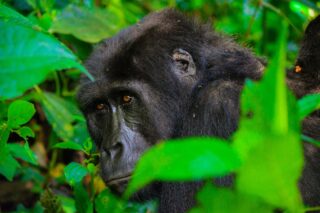
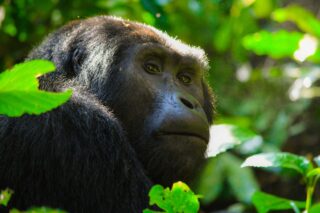

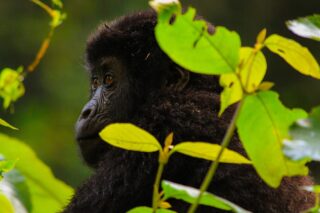
Bwindi National park really is spectacular. Those steep hills are cloaked in deep forest, a mixture of many different types of trees. This type of forest is known as Afromontane and it is a feature of the Albertine Rift, which runs through the park. During the wet seasons, which are March to April and September to November, the forest functions as a water catchment area. The rains drip down the trees to form streams, an excellent water source for the gorillas and many other species. The high density of forest also causes a phenomenon known as evapotranspiration, in which water transfers from both the soil and the trees to the atmosphere – and further rain results.
The national park was established in 1991, bringing together three reserves – the Impenetrable Central Forest Reserve, the Mgahinga Gorilla Reserve, and the Rwenzori Mountains Reserve. All of these had been set up in the 1960s, for the purpose of protecting the resident mountain gorillas. In April 1993, it became possible for travelers to track the gorillas; in 1994, the national park was added to the World Heritage List, following the addition of an area measuring 10 square kilometers. Another area was bought for Bwindi in 2003, and to this day gorilla tracking brings a lot of revenue to park managers Uganda Wildlife Authority. The mission of the UWA includes conserving, economically developing, and sustainably managing the wildlife of this beautiful part of the world.
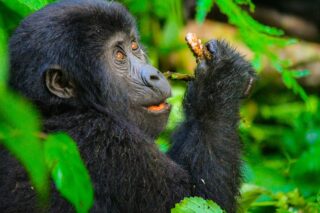

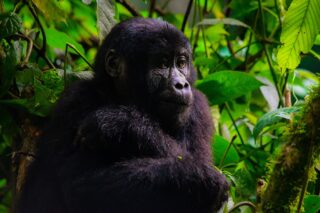

Volcanoes National Park borders Virunga National Park in the Democratic Republic of Congo (DRC) and Mgahinga Gorilla National Park in Uganda. Five of the eight volcanoes in the Virunga Mountains can be found here. The volcanoes and highlands of the park are covered in lush rainforest and bamboo (a favourite snack of the gorillas). While the most famous resident is the mountain gorilla, there’s plenty of other wildlife roaming around: buffaloes, bushbucks, golden monkeys, hyenas, numerous bird species, and some elephants call this place home.
Approximately 800 mountain gorillas exist globally in the wild today. They are found in Rwanda, DRC, and Uganda. In DRC and Rwanda, gorillas live in similar ecosystems/areas. The gorilla species found in these three areas are called highland gorillas.
In Rwanda there are ten habituated gorilla families that are open to visits – the visit to a gorilla family is done once per day, with a maximum 8 trekkers per group and the duration of a visit is limited to one hour with the gorilla family. The time spent with them is limited due to conservation considerations and to minimize impact on the day-to-day life of the gorilla family you are visiting. It is important to be well prepared for the trek — you never know if your total trek will be short or long. The total duration of a trek can vary and be anything between 4 and 9 hrs in length depending on the location of the gorillas, which are constantly moving. You will mainly walk where there are no paths apart from the occasional buffalo or elephant trail.
Touching the gorillas is not allowed (although in some cases they may touch you). Making loud noises or sudden movements is also not allowed.
Approximately 800 mountain gorillas exist globally in the wild today. They are found in Rwanda, DRC, and Uganda. In DRC and Rwanda, gorillas live in similar ecosystems/areas. The gorilla species found in these three areas are called highland gorillas.
In Rwanda there are ten habituated gorilla families that are open to visits – the visit to a gorilla family is done once per day, with a maximum 8 trekkers per group and the duration of a visit is limited to one hour with the gorilla family. The time spent with them is limited due to conservation considerations and to minimize impact on the day-to-day life of the gorilla family you are visiting. It is important to be well prepared for the trek — you never know if your total trek will be short or long. The total duration of a trek can vary and be anything between 4 and 9 hrs in length depending on the location of the gorillas, which are constantly moving. You will mainly walk where there are no paths apart from the occasional buffalo or elephant trail.
Touching the gorillas is not allowed (although in some cases they may touch you). Making loud noises or sudden movements is also not allowed.
